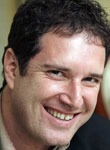Self-correcting robots, at-home 3-D printing are on horizon, says Lipson at AAAS
By Anne Ju

Robots that can self-improve and machines that "print" products at home are technologies soon to become increasingly available, said Cornell's Hod Lipson at the 2011 American Association for the Advancement of Science (AAAS) annual meeting, Feb. 17-21.
Lipson, associate professor of mechanical and aerospace engineering and of computing and information science, said Feb. 19 that robots can observe and reconstruct their own behaviors and use this information to adapt to new circumstances.
Such advances are important because self-reflection plays a key role in accelerating adaptation by reducing costs of physical experimentation, he said. Similarly, the ability of a machine to reconstruct the morphology and behavior of other machines is important to cooperation and competition. Lipson demonstrated a number of experiments on self-reflecting robotic systems, arguing that reflective processes are essential in achieving meta-cognitive capacities, including consciousness and, ultimately, a form of self-awareness.
In a second talk (Feb. 21), Lipson discussed the emergence of solid free-form fabrication technology, which allows 3-D printing of various structures, layer by layer, from electronic blueprints. While this technology has been in existence for more than two decades, this process has recently been explored for tissue engineering. In particular, new developments in multimaterial printing may allow these compact "fabbers" to move from printing custom implants and scaffolds to "printing" live tissue.
His talk also touched on his experience with the open-source Fab@Home project and its use in printing a variety of biological and non-biological integrated systems. He concluded with some of the opportunities that this technology offers for moving from traditional biomaterials to digital tissue constructs.
Lipson directs Cornell's Computational Synthesis group, which focuses on automatic design, fabrication and adaptation of virtual and physical machines. He has led work in such areas as evolutionary robotics, multimaterial functional rapid prototyping, machine self-replication and programmable self-assembly. He was one of five Cornell faculty members who presented at this year's AAAS meeting.
Media Contact
Get Cornell news delivered right to your inbox.
Subscribe